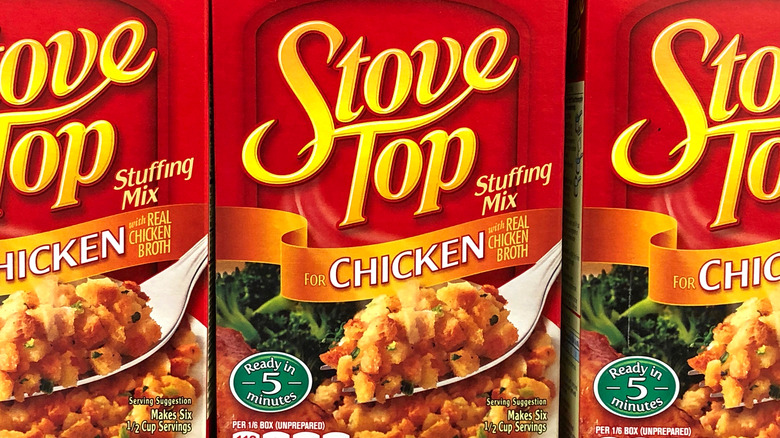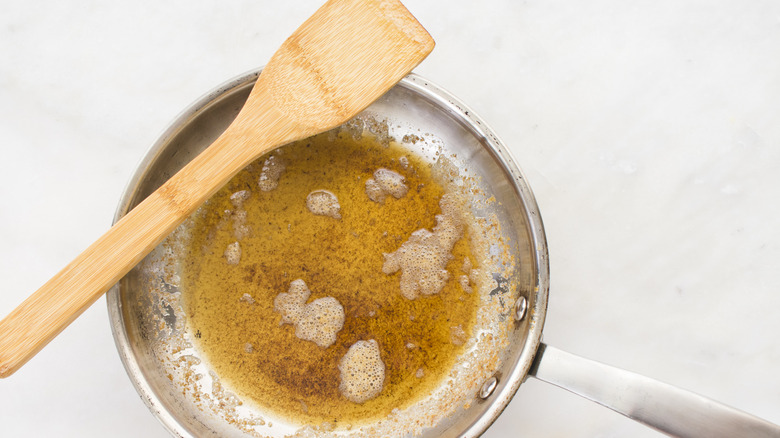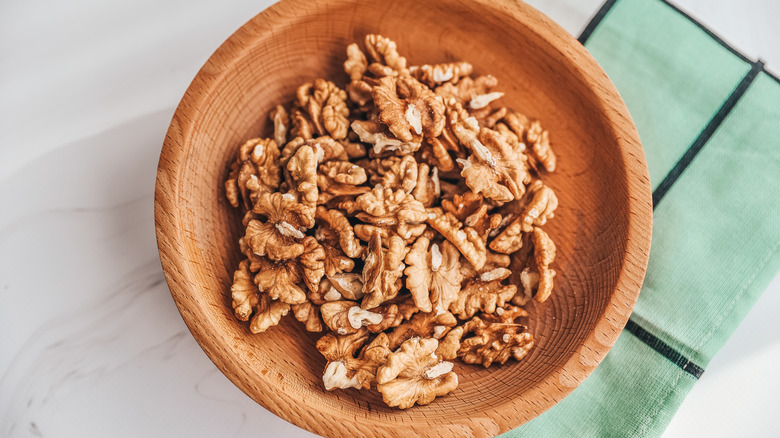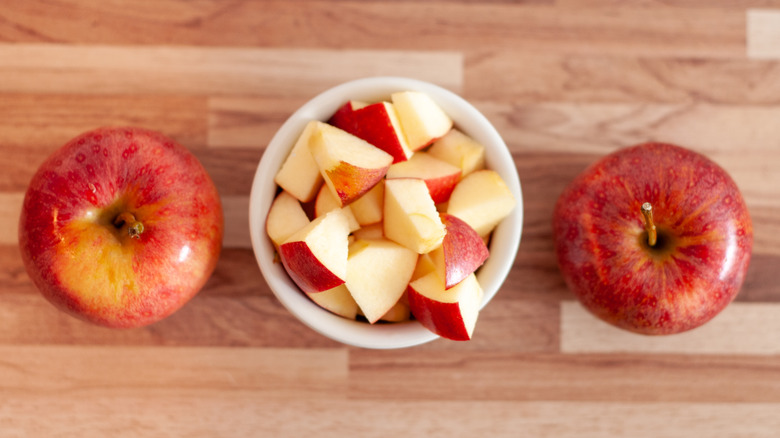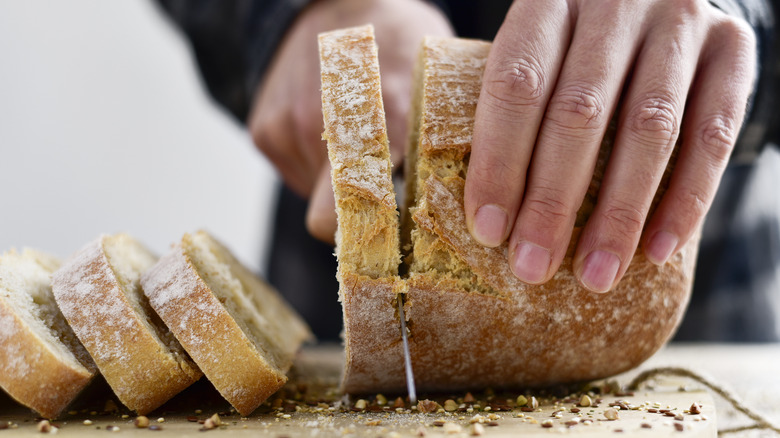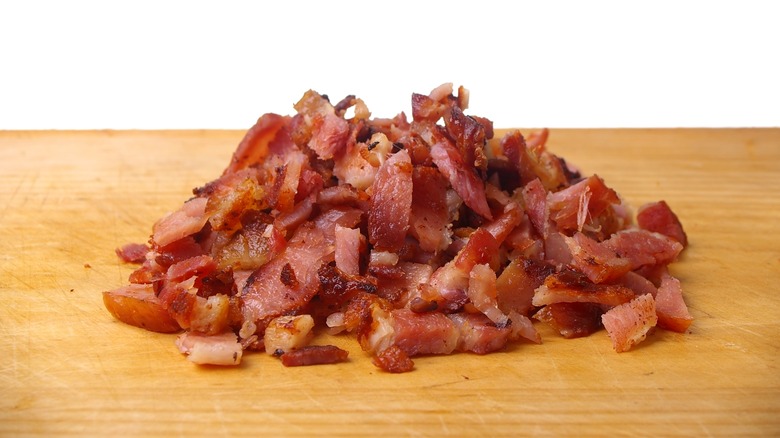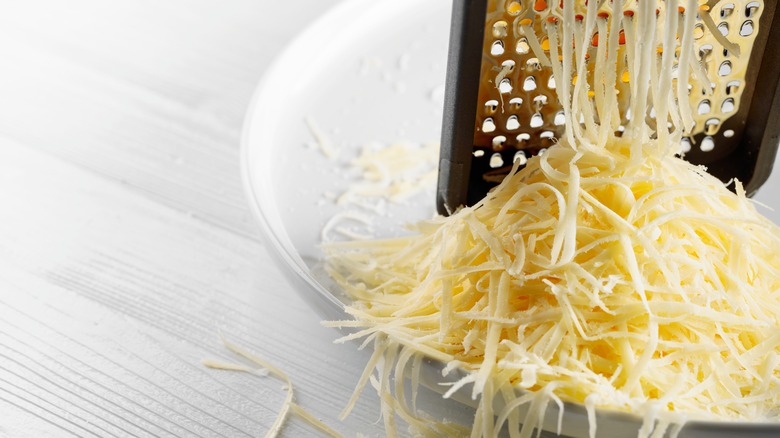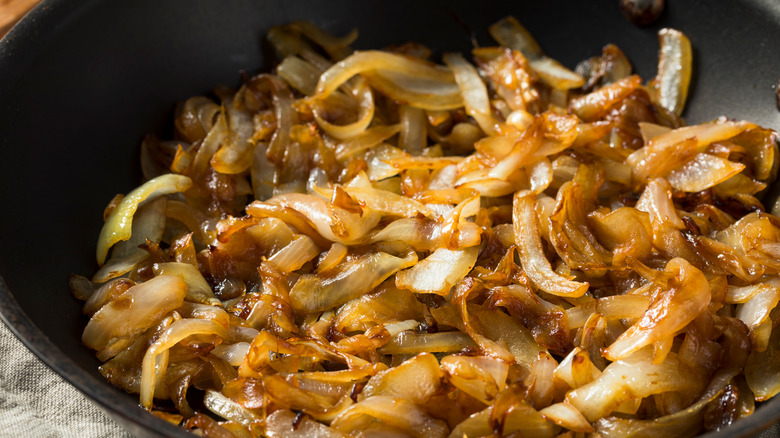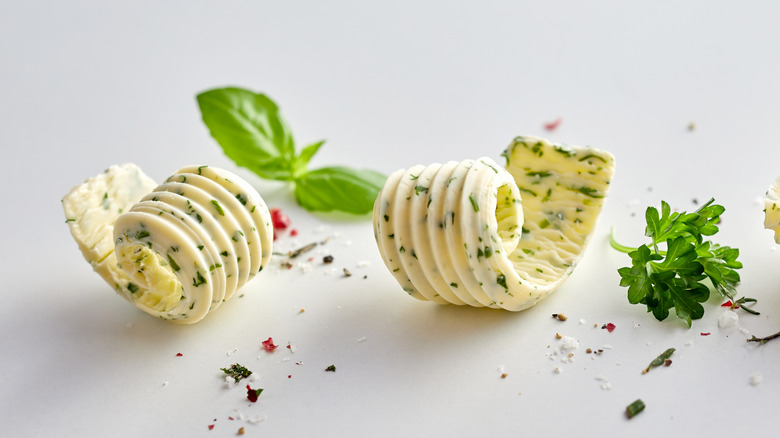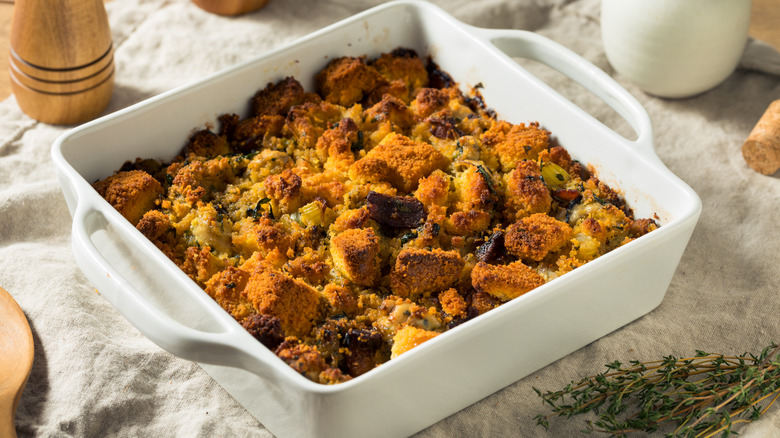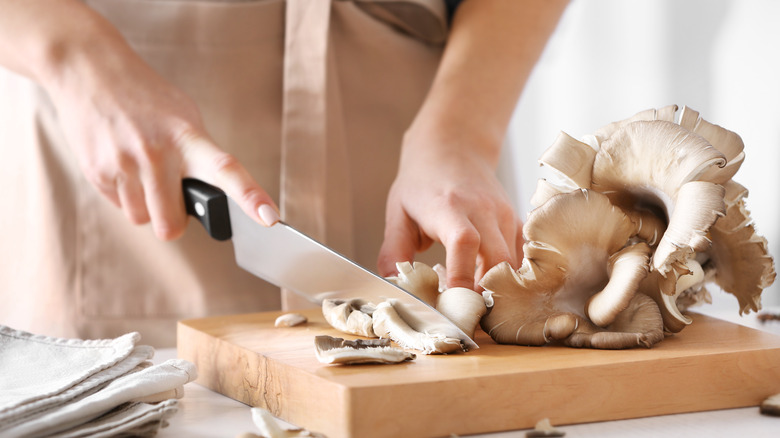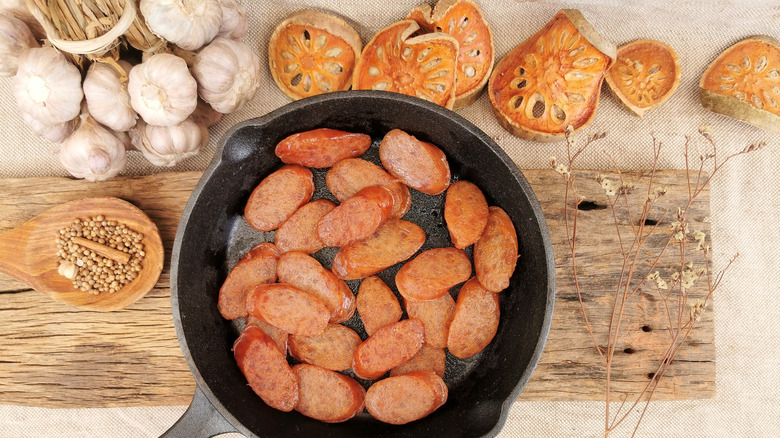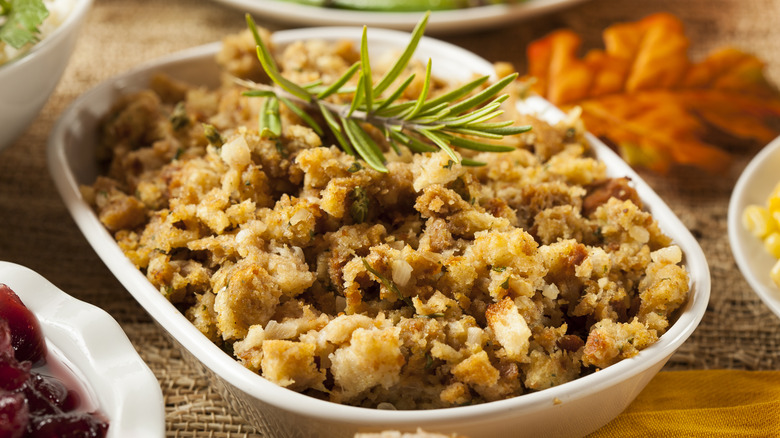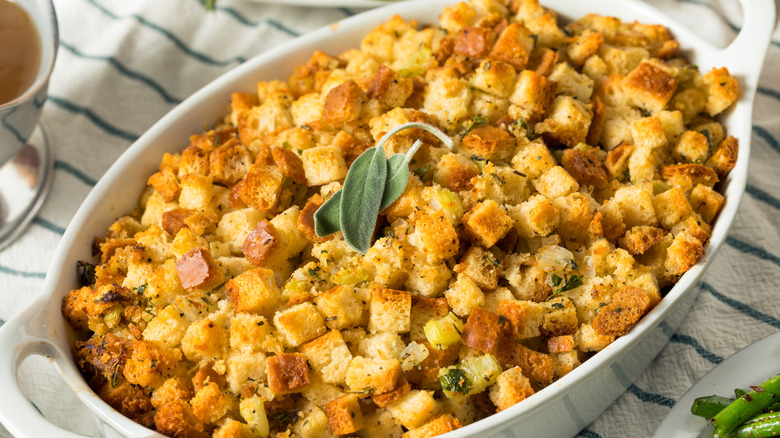14 Ways To Make Packaged Stuffing Mix Taste Homemade
Boxed stuffing can be a lifesaver during the holiday cooking season. While turkey can take hours to cook perfectly and pumpkin pie is arduous to get to set just right, boxed stuffing can come together by bringing in just a couple of additions like binders and stock. Simply combine it all together and bake. The one downside to relying on going the pre-packaged route?: Sometimes, it can just taste mediocre.
Luckily, there are plenty of ways to ensure that doesn't happen. If you're looking to upgrade your boxed stuffing, you'll want to start by picking a great brand of packaged stuffing. Our personal favorites include the Williams Sonoma Organic French Bread Stuffing and the cheaper Stove Top Savory Herb Stuffing Mix. You'll want to use a mix with decent-sized bread chunks to soak up all the flavor of your tasty additions, as well as one with a decent background flavor so you can focus on the unique spin you want to put on your stuffing. Once you've procured a quality packaged option, be sure to take advantage of some of our favorite ways to make packaged stuffing taste homemade.
1. Swap regular butter for brown butter
One of the best ways to make any food better? Make brown butter. Stuffing can benefit from the warmth and caramelized notes of the butter — and it has the same binding potential as other ingredients. Binding is an important component of any stuffing; the binding agent (such as egg or butter) causes the bread to stick together with the other add-ins. If you want to avoid crumbly stuffing you'll need to keep your stuffing binders in check.
Brown butter is simply standard butter that has been toasted over heat to infuse more nutty notes and that signature caramelized flavor. This is the result of a chemical process called the Maillard reaction. The heat from the stove evaporates the moisture from the butter, thus leaving behind the milk solids and fat. When the sugars and amino acids in the brown butter are exposed to heat, a nutty and toasted flavor is produced.
You can add non-fat powdered milk to the pan as the butter cooks to help create more nuttiness in your butter — since the shelf-stable product is just concentrated milk solids. When you're cooking your butter, you'll want to watch out for brown flecks and a nutty aroma from your butter. After all, you won't want to add burnt butter, rather than browned butter, to your homemade stuffing recipe.
2. Incorporate chopped nuts for texture
One of the best ways you can elevate your stuffing is with diverse textures. And there might not be a better way to add a unique crunch to your homemade stuffing than to toss in a couple of handfuls of chopped nuts to your stuffing. You should add raw nuts to your stuffing right before you bake it in the oven. Raw nuts have not been roasted and are not already salted. Although roasted nuts might be a bit more crunchy than raw nuts, that additional time in the heat of the oven may foster some unsavory burnt notes.
The exact type of nuts you should add to your stuffing depends on what kind of flavors you're looking to impart on your side. If you're using chopped pears, cranberries, or apples, you may consider adding chopped pecans or walnuts. The flavor of these nuts is relatively mild and complements the sweetness of the fruit in your stuffing.
3. Make a fruity addition
When it comes to stuffing, most people think savory. But with the addition of chopped fruit, you can elevate the sweetness of your boxed stuffing. Numerous fruits are suited for stuffing in both fresh and dried forms. When working with fresh fruit, you should be aware that cooking it down can cause a bit more moisture in your stuffing. We recommend cooking down your fresh fruit before adding it to your stuffing to allow it to release some of its moisture. Dried fruit, on the other hand, will absorb a marginal amount of moisture.
Dried cranberries provide a uniquely soft texture and tanginess to a country bread stuffing recipe, especially when paired with herbs like sage and tarragon or salty additions like sausage or bacon. Apples, especially baking varieties like Cortlands and Golden Delicious can fit with a similar flavor profile. If you're adding apples to your stuffing recipe, make sure to peel them and chop the flesh into very small pieces. That way, the flavors of your apple will fit in the same mouthful as a salty bite of sausage and crispy bread. You can also use small chunks of pear in your stuffing for a less sweet and slightly more complex flavor than apples.
4. Bulk up the stuffing with unique bread
Boxed stuffing usually contains cubes of crunchy bread that can withstand a ton of binders, butter, and flavor. But to enhance the flavor and texture of your boxed stuffing, you should consider adding a bit of your fresh bread to the mix. The Bread Guide suggests sticking to neutral-flavored bread with a tight crumb structure. (The phrase "tight crumb" refers to bread that doesn't have a lot of holes.) Those include challah, brioche, or rustic Italian white bread. Highly-hydrated rye bread and whole-grain bread are much too wet for a good stuffing texture. If you're looking for a bit of crunch, you can crumble up pretzels and add the shards to your boxed stuffing mix. We've found that gluten-free pretzels can withstand the moisture of the stuffing just as well as the snacking pretzels you find at your neighborhood convenience store.
Martha Stewart recommends drying out small pieces of bread for your stuffing the day before you plan to incorporate the chunks into your stuffing. Baking the bread pieces low and slow means that your bread won't be soggy when it's baking and will keep its shape when combined with binders.
5. Substitute beer for some of the broth
You might not think "make it boozy" would be a go-to suggestion, but substituting beer for stock in stuffing is an easy way to upgrade the depth of your stuffing. The standard rule for boxed stuffing is to use one cup of broth for every four cups of bagged stuffing. We love the flavor of dark ale in stuffing, but the maltiness of the beer can be a bit overpowering for some stuffing snobs. The subtle citrus notes of a hefeweizen can provide a bit more tangy and punchy flavor to the stuffing.
If you've never cooked with beer, the King Arthur Baking Company first recommends letting it sit for about five minutes after opening to diminish some of the foam and release some of the carbonation. This is especially important for stuffing because the beer is acting as a flavoring rather than a lifting agent.
6. Use fatty meats like bacon and pancetta
You should never underestimate the power of adding fatty meats to otherwise mild flavors. Bacon, along with similar meats like pancetta, certainly fits the bill, and it can make all the difference in your stuffing. A bacon and jalapeño stuffing is an ideal pairing. You can render the bacon in a pan for a few minutes before sautéing your vegetables in the leftover grease for extra porkiness — we never said stuffing had to be healthy after all. You can lighten the richness of the meat by using turkey bacon instead.
The key to adding fatty meat to your stuffing is to cut the meat into small, bite-sized pieces and avoid adding the stuffing raw. A change in color from pink to brown and slightly fluted edges will indicate that your bacon is finished cooking. Since you're cooking the bacon twice (both before and in the stuffing), you'll want to get just enough crispiness on the bacon so that it holds its shape with the other stuffing ingredients.
7. Grate in cheese
Say cheese! This addition to your stuffing is sure to make your tastebuds smile. You can add several different cheeses to your stuffing, but some of the most popular types include grated parmesan and cheddar. You can play with different degrees of sharpness when you select your cheese. We recommend pairing grated Parmigiano-Reggiano with our other favorite salty stuffing ingredient: oysters. The parmesan adds a bit of dryness and mild cheese flavor; it's the perfect pairing for a grainy cornbread-based dressing. Plus, the flavor of the cheese isn't strong enough to overpower the vegetables or cornbread.
Sharp cheddar, on the other hand, pairs well with ingredients like bacon, onion, chives, and apples. You can grate this cheese with the bread and other ingredients, or just stick to adding a thick cheesy layer to the top of the stuffing before baking. Just don't forget to pull the foil off the top of the stuffing so you can get a bit of melty, sharp cheddar flavor.
8. Add caramelized onions
Caramelized onions aren't just a great burger or Philly cheesesteak topping. It's also a great addition to your boxed stuffing. Cooking your onions down before adding the allium to your stuffing will add an unexpected sweetness and nuttiness to the dish. They pair well with other flavor amplifiers like chopped sausage, sage, apples, and brown butter.
Caramelizing your onions properly will take time, but it's worth the effort. Keep in mind that you can also make a big batch and defrost the onions when you need them. Besides the onions and oil, you should also keep a box of stock handy. Adding the liquid to your onions as they cook can discourage burning and encourage a deeper caramelization. This entire process can take upwards of 45 minutes, so you should allocate enough time in your busy cooking schedule to make caramelized onions properly. After all, you want caramelized — not lukewarm onions.
9. Infuse herbs into your butter
Butter can be a vessel for other flavor notes with a bit of creative spirit. One of our favorite fusions to make for boxed or scratch-made stuffing is sage butter. You'll just need to use equal parts fresh sage leaves and butter and cook for less than a minute on the stove before removing the butter from the heat. Drizzle the finished herb butter over the stuffing and allow it to cool for a few minutes before enjoying.
You can also make a spring herb compound butter to melt over the top of your stuffing by adding chopped parsley, chives, lemon zest, and salt together with room-temperature butter. And if you have leftover compound butter in your fridge, you can store it in a plastic-wrapped log for breaking off and schmear on perfectly toasted and crunchy toast. You won't go back to using plain butter ever again.
10. Give it a salty, seafood spin
If shellfish makes you squeamish, you might want to skip over this one. But if you are a fan of the salty, straight-from-the-sea flavor and don't mind a bit of squishiness, you may consider making an oyster dressing with your boxed stuffing mix. (Note that "stuffing" is traditionally cooked inside the cavity of the turkey while dressing is cooked separate from the bird.) And since the plump bivalves add an extra layer of moisture to this dish, you won't ever have to worry about dry, under-salted stuffing ever again.
According to Gastronomica, the first oyster stuffing recipe published in the U.S. dates back to 1796 and it remains a celebrated side. To make the oyster dressing, you'll just need to add some raw oysters with their juice with the boxed stuffing and bake. You can use either canned oysters or fresh oysters, but if you want to avoid the arduous (and somewhat dangerous) task of shucking, you should stick to the canned version.
11. Focus on umami-rich ingredients
The elusive umami is a flavor chefs try to capture in their food — stuffing included. Scientifically speaking, umami -rich-ingredients impart a complex, meaty flavor thanks to the presence of glutamate. (Ingredients that contain glutamate include onion, tomato, sardines, chicken, and beef.)
Our favorite way to impart umami flavors onto a boxed stuffing is to include porcini or shiitake mushrooms. Shiitake mushrooms are very mild when eaten raw, but take on a much more complex flavor after being cooked and added to stuffing. Porcini mushrooms are commonly used in French and Italian cuisines for their intense woody flavor and compatibility with ingredients like butter and cream. While your go-to might be adding umami-rich porcini mushrooms to your risotto, you can cut up the mushrooms into super tiny pieces and combine them with the rest of your boxed stuffing. For even more umami flavor, add a splash of soy sauce to replace the salt in your recipe.
12. Stick to a flavor theme
One of the goals of cooking is to develop excellent flavor cohesion. And if you stick to a regional flavor profile, such as Asian or Italian, you will find it much easier to structure your flavors around that profile. For Asian-inspired stuffing, you'll want to use ingredients like chopped green onions, Sichuan peppercorns, and Chinese sausage to flavor your stuffing. Chinese sausage is a blanket term for fatty pork-based sausages originating from China, Laos, Thailand, and Vietnam. This sausage can be integrated with fresh herbs, glutenous rice, and boxed stuffing for a savory and less conventional stuffing recipe that is bound to quickly become a favorite.
You can also stick to more classic stuffing ingredients like parsley, oregano, spicy or sweet Italian sausage, and a bit of chopped fennel. The fennel adds a contrasting crunch to the softness and fattiness of the sausage, as well as the freshness from the chopped herbs.
13. Don't skimp on the herbs
If you're looking for brightness in your stuffing, you should look no further than fresh herbs. Fresh herbs can add a nuanced organic flavor to your stuffing and can also add a personal touch that the neutral shade of boxed stuffing just doesn't provide. Fresh herbs provide more vibrant colors and flavor to your stuffing compared to the earthy and more pungent notes of dried herbs. If you're looking to instill deeper flavors into your dish, stick to using dried herbs and adding them earlier on in the cooking process. This will instill a stronger aroma and flavor than if you were to add dried herbs right before your stuffing is about to go into the oven.
There are numerous different types of herbs you can use to make boxed stuffing your own. Fresh parsley can add a pop of bright green and relatively clean flavor while rosemary provides a slightly piney and aromatic element to stuffing.
14. Always finish your stuffing uncovered
Whether boxed or prepared from scratch, the perfect stuffing is delectably soft and plush on the inside, but not too soggy. If you leave your stuffing in the oven covered during the whole duration of its cooking time, you will likely get a soggy stuffing that resembles a wet ball of goop rather than a crave-worthy side dish. To add an extra layer of crunch on the outside of your stuffing, you'll want to bake it in the oven uncovered for the last 15 minutes or so. This will result in a stuffing with an exterior that has a little bit of crunch and an interior that is soft and moist. Another important way to ramp up the textures of your stuffing is to brush the top of the stuffing with melted butter before putting the tray in the oven.
You can also use a shallow baking dish to increase the surface area of the stuffing exposed to heat. Muffin tins can make a more portable and crispy stuffing for special occasions as well; we recommend filling the center of the "stuffins" with a hearty serving of mashed potatoes and gravy.
